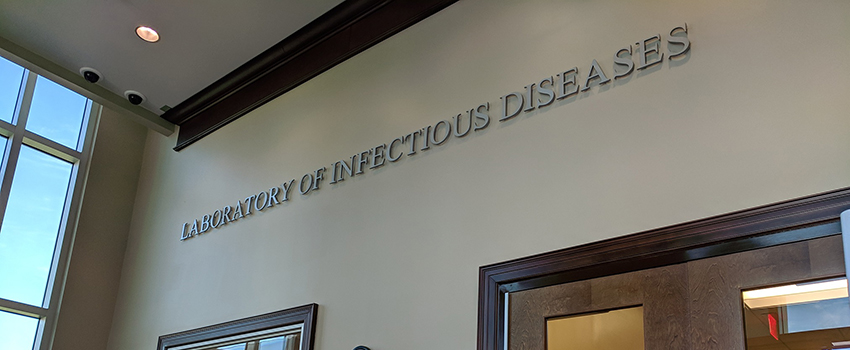Laboratory of Infectious Disease (LID)

About the LID
The Laboratory of Infectious Diseases (LID) at the University of South Alabama, located on campus at 610 Clinic Drive, was funded by a National Institutes of Health Construction grant and became functionally active in February 2015. The LID is designed to provide state-of-the-art research facilities dedicated to the study of microbial pathogens of importance in public health and biodefense.
The facility includes biosafety level (BSL) 2 and 3 research laboratories, an animal BSL-3 suite, and an arthropod containment level (ACL) 3 unit for work with risk group (RG) 2 and 3 pathogens. The LID maintains a Certificate of Registration for Select Biological Agents from the Centers for Disease Control and Prevention that is valid through June 2026. The facility's design and associated laboratory practices include enhanced biosafety and biosecurity features to support work with Tier 1 select agents should it be necessary.
Current research efforts at the LID are aimed at understanding the molecular pathogenesis of emerging and re-emerging infectious diseases and the development of animal models and assays to support early stage drug discovery and development. Immunological assays developed in support of these preclinical studies are being further developed and validated to support human clinical trials of new candidate vaccines.
In collaboration with the Biology Department in the College of Arts and Sciences, researchers at the LID are also supporting mosquito and tick-borne infectious disease surveillance efforts in the state of Alabama to better inform public health departments and clinicians on the risk of human exposure to arthropod-borne infectious diseases. Pools of mosquitoes and ticks from these programs serve as a valuable resource for environmental isolates of important human and animal pathogens and also for future research efforts focused on the development and validation of molecular methods and whole genome approaches to improve emerging infectious disease surveillance efforts.
BSL-2
In support of research activities, the BSL-2 laboratories include five rooms of approximately 1,000 square feet each, along with two tissue culture rooms and multiple shared rooms for microscopy and molecular biology support. Major equipment includes:
- Class II, Type A2 Biological Safety Cabinets (BSCs)
- Water jacketed CO2 incubators
- QuantStudio 5 and StepOne real-time PCR systems (Applied Biosystems)
- iSeq 100 Sequencing System (Illumina)
- Luminex MAGPIX system
- Synergy 2 plate reader (BioTek)
- Beckman Coulter 22R refrigerated microcentrifuge
- Eppendorf Vacufuge
- NanoDrop 1000 spectrophotometer
- Eclipse Ts2 inverted tissue culture scope
- Millipore Elix deionized water system
- Upright ultralow freezers
- 4 degrees Celsius coolers
- Allegra X30R benchtop refrigerated centrifuge with fixed angle and swing bucket rotors (Beckman)
- Air Clean PCR Work Station
- New Brunswich gyratory incubators (Excella E24 table top and C25 floor)
- 96 well MasterCycler gradient thermocyclers (Eppendorf)
- Immunospot Analyzer (Cellular Technologies Limited)
- ChemiDoc gel documentation system (Bio-Rad)
- Allegra 6R centrifuge (Beckman Coulter)
- Eppendorf centrifuge 5417R and 5424 and 5425
- Eppendorf BioPhotometer Plus
- LMI6000 LED fluorescent inverted microscope with SeBaView Software (Laxco)
- Eclipse 90i microscope (Nikon) with NIS elements software
- Milli-Q water system
- Upright -20 degrees Celsius freezers
- PCR Work Station (Mystaire)
- TissueLyser II (Qiagen)
BSL-3
The BSL-3 Laboratory Space includes six labs of approximately 300 sq. ft. that can be dedicated to individual researchers working with different pathogens and a seventh laboratory of 600 sq. ft. containing a 180 sq. ft. BioBubble for arthropod containment. Major equipment for the BSL-3 laboratories includes:
- Thirteen Class II, Type A2 Biological Safety Cabinets
- A Class II, Type B1 Biological Safety Cabinet
- Five water jacketed CO2 incubators
- Thermo Barnstead MaxQ 4000 gyratory incubator (tabletop)
- Beckman Coulter Avanti JE refrigerated high speed centrifuge
- Two inverted tissue culture scopes
- BTX electroporation system
- Three ultralow chest freezers plus one additional ultralow chest freezer as emergency backup
- Four over/under freezer/refrigerator units
- Three microfuges with safety rotors/cups (Eppendorf 5804, 5702 and 5430)
- Fisherbrand Beadmill 4 bead beater
- Helios plate reader
- Nikon Eclipse TE2000-U fluorescent microscope with Nikon Elements software and Z-axis capability
- Beckman Coulter MoFlo XDP 8-color fluorescence-activated cell sorter housed within a custom Biological Safety Cabinet to facilitate experimentation with Risk Group 3 pathogens
- Mettler Toledo ML54T analytical balance
- Dissecting microscope with LCD Screen OptiCam attachment
- Nanoject II auto microinjector (Drummond Scientific)
- TissueLyser II (Qiagen)
Additionally, the ABSL-3 suite housed within the BSL-3 research area is approximately 551 sq. ft. total and consists of two animal holding labs, a procedure room, and an ante-room for staging equipment and supplies. The suite includes two Class II, Type A2 Biological Safety Cabinets (BSCs); a Class II, Type B1 Biological Safety Cabinet; and two Lab Products ventilated cage racks with micro-isolator caging to house small animals.


